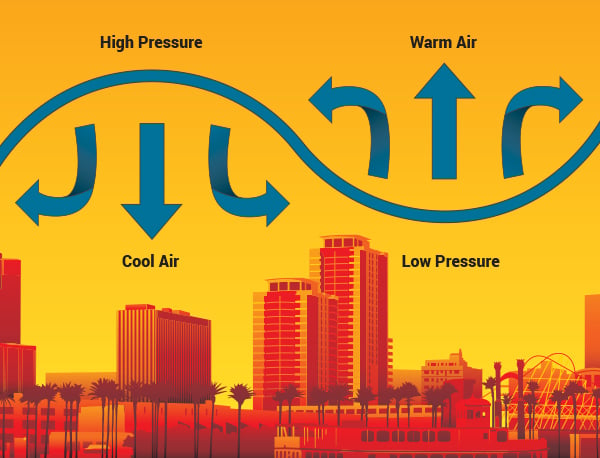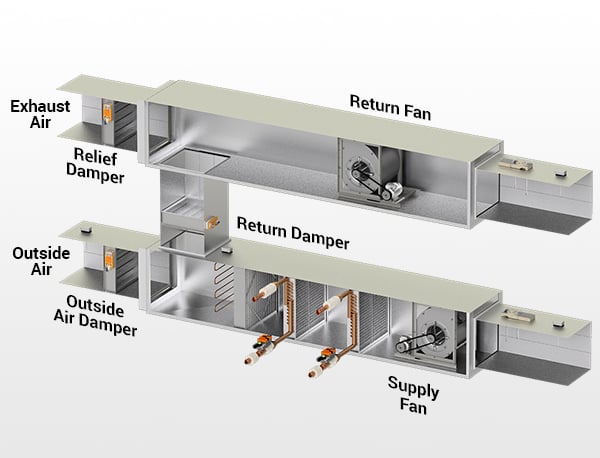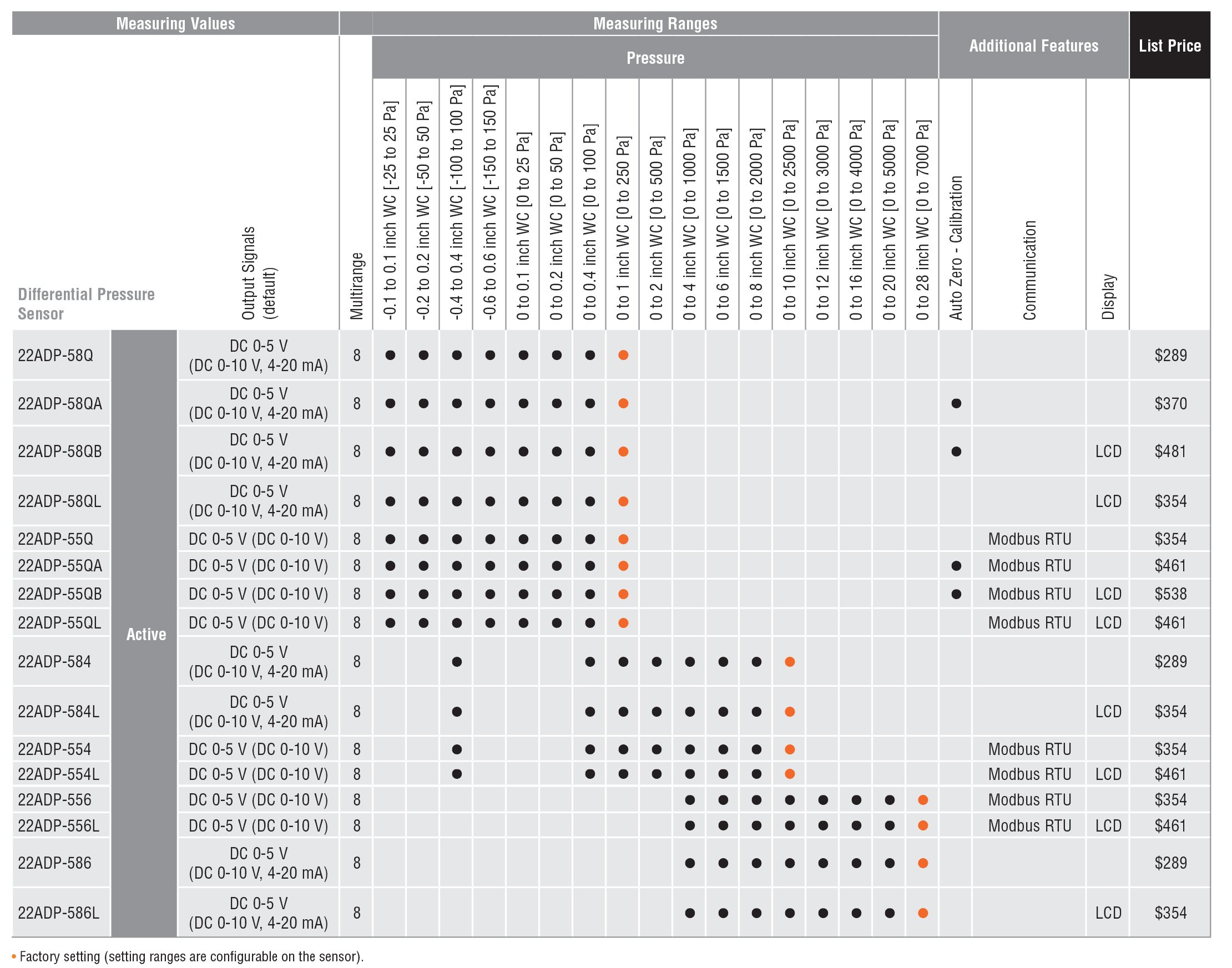The Importance of Measuring Air Pressure in Commercial Buildings
- Air pressure and how it affects commercial buildings
- Effects of not managing building air pressure correctly
- How to control the air pressure
- Measuring pressure
- Calibration
- Installation advice and setpoints
Air pressure is the weight of air molecules pressing down onto the earth and objects. (refer to Figure 1). For instance, cool air molecules are heavier and denser causing the force applied to a structure to be greater while warm air molecules are lighter and have lesser force on the building. There are other complicating factors such as wind, weather and seasonal changes, which will also produce variations in pressure.
Temperature and wind are what primarily affects pressurization of a building. Devices created to control the indoor environment, air intakes, exhaust fans, economizers, and relief dampers all affect inside building pressure. These mechanical systems create either positive or negative pressure in buildings.
Slight positive pressure will help keep hot outside air from penetrating into the building during the summer. Negative pressure during the winter will allow outside air into the building to maintain humidity. Control of the air pressure inside the building is key to keeping the building comfortable.

Figure 1: Air Effects on Commercial Buildings
Effects of Not Managing Building Air Pressure Correctly
While inside a building, you have probably experienced the following issues: air stratification, high indoor humidity, drafts, hot/cold spots, and high-energy usage. These items change significantly depending on where you are located in the building and the season of the year.
In a negative air situation, high humidity in the summer can creep into the building, defeating your attempts to condition the air for the comfort of the people that occupy the building. The quality of the construction of the building can cause drafts that can be difficult to track down and correct. Windows not correctly installed and doors that are misaligned or damaged all contribute to the problems.
Have you ever experienced a door dragging you into the building as you opened it due to negative air pressure inside the building? Equally, you have no doubt tried to open a door that required superhuman strength to get it open, then having to pull it shut behind you because of negative pressure. Positive pressure causes the opposite problem; the door flies open while getting it closed requires your full strength.
This brings up the question of how to overcome the antics of people in the building doing everything they can to destabilize building pressure without even knowing what the effect is on the building.
How to Control the Air Pressure
Both supply and exhaust fans help to provide a flow of air in and out of buildings. Dampers are installed to allow outside air in the building and keep debris and animals out. The exhaust damper lets air out. Control dampers regulate how much air to take in and exhaust out. Any gross differential air taken in and the amount exhausted will cause your positive and negative pressure conditions discussed earlier. The dampers are the internal recirculation correction factor to establish the desired air pressure. A system requires many sensors to make it all work efficiently. There are many variations on how to design the mechanical system.

Figure 2: Simplified Internal Mechanical for Controlling Air Pressure
Some systems use relief fans rather than return fans. The pros and cons of that are shown in Tables 1 and 2.
 Table 1: Pros and Cons of Return Fans
Table 1: Pros and Cons of Return Fans

Table 2: Pros and Cons of Relief Fans
Measuring Pressure
You cannot manage the air pressure in a building until you can measure it. Belimo manufactures a family of three differential pressure sensors in the 22ADP series. Figure 3 illustrates the range each sensor is capable of measuring.
Differential pressure sensors offer:
- Eight selectable field ranges
- Spring loaded terminal blocks for easier wiring and commissioning
- Manual calibration
- Velocity output (option)
- ½” Conduit and cable fittings are included
- Optional LCD readout
- Optional true auto-zero calibration
- Optional Modbus communications
- Universal NEMA 4X/IP65 enclosure
- UL compliant

Figure 3: 22ADP Pressure Sensor Series
The ADP sensor technology illustrated on the circuit diagram illustrated below shows that the piezoresistive pressure sensor and Wheatstone bridge are better than a strain gage because it is more stable and can measure smaller increments of pressure. Because of that, this sensor can detect smaller pressure changes due to deformation of the duct walls. The benefit of the 22ADP, increase sensitivity and better linearity at a constant temperature and can track pressure changes without signal hysteresis. This low-level accuracy is essential when measuring building pressure. The Belimo 22ADP sensor with pressure ranges 0 to 1” offers an accuracy of ±0.004 inches wc. The setpoint of detection for any building runs from ±0.05 wc. With the 22ADP sensor high accuracy, your system can detect when the differential pressure exceeds those setpoints.

Figure 4: Sensor Technology
Calibration
Sensors require calibration  regularly. The 22ADP series offers true auto-zero calibration. An electromechanical valve on the PCB makes an air short-circuit between the positive and negative pressure port of the differential pressure sensor element, causing both ports to equalize pressure. If there is a value measured, that value is the drift and is stored. Until the next zero-point calibration is made, the last measured drift is compensated. This effectively removes the drift. The sensor is maintenance free and eliminates the need for 2 to 3 site visits per annum, which is recommended for critical applications.
regularly. The 22ADP series offers true auto-zero calibration. An electromechanical valve on the PCB makes an air short-circuit between the positive and negative pressure port of the differential pressure sensor element, causing both ports to equalize pressure. If there is a value measured, that value is the drift and is stored. Until the next zero-point calibration is made, the last measured drift is compensated. This effectively removes the drift. The sensor is maintenance free and eliminates the need for 2 to 3 site visits per annum, which is recommended for critical applications.
Most of the time when sensors are installed, it is the only time they are calibrated. Other low-pressure differential sensors are vulnerable to drift and require attention that is more frequent. As time passes, sensors need to be checked and recalibrated to maintain system efficiency.
Installation Advice and Setpoints
High-pressure ports are installed inside the buildings and low-pressure outdoors. It is not recommended to install high-pressure measurement points in lobbies or reception areas. The door opening and a gust of wind can cause an inaccurate pressure measurement.
Choose a location that best represents the area you are monitoring. Multiple sensors may be required. For outdoor low-pressure ports, choose probes that will keep out dust, insects, and debris. Avoid installing the outdoor low-pressure ports on the windward side of the building. Gusts of wind can cause false positive alarms on indoor high-pressure ports. The sensor will provide inaccurate readings to the control system.
Avoid installing probes where they can collect moisture and freeze because you will not get a signal. The problem occurs when the air from an outdoor probe condenses inside, and the moisture builds up. Cold air flowing behind it will freeze at the wall entry port effectively blocking any measurement.
Avoid running the poly tubing from port to sensor for excessively long distances. The pressure in the poly tubing will degrade and provide an inaccurate measurement to the sensor. The shorter the run, the better. General guidelines for quarter inch poly tubing limits the run length up to 100 feet. Three-eighths inch poly tubing can withstand runs up to 250 feet. If any tubing run exceeds these numbers, look for a better place to install the sensor.
A good overall sensor setpoint is 0.05” wc. Buildings monitored by high-pressure sensors located on the first floor should have slight negative pressure in the winter and even a bit lower in colder climates. It is not a bad idea to draw in some cold air to lower the humidity. In hotter climates, you may have to raise the setpoint to 0.10 inches wc to keep the heat and humidity out of the building. Ultimately, the sensor setpoints to use are based on the building construction method. Setpoints are are a little higher in buildings with free airflow between floors. The construction quality of the building also matters. Tight construction with only minor leaks and poor construction with significant leaks (doors, windows, etc.) will cause you to shift the setpoints to counter the deficiency.
When installing sensors controlling multiple VAV AHU’s for a single space, like gymnasium or building areas with excessively open floor plans, make sure you are using the same pressure sensor for all AHUs and their pressure schemes. Otherwise, they can fight each other and cause a wind tunnel effect.
Measuring and maintaining air pressure in buildings is essential to ensure a precision controlled, comfortable room environment that is essential for the well-being and productivity of the people.

